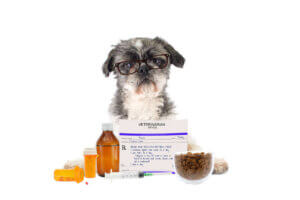Which Are the Most Dangerous Medicines for Dogs?


Written and verified by the vet Juan Pedro Vazquez Espeso
Dogs have gained great ground and popularity as pets in recent years. With this expansion, it’s difficult not to tend towards the humanization of these furry animals and think that they’re like us in all aspects, even when it comes to medicine. As a good reader and animal lover, you surely know that there are many drugs for human use that are very dangerous for dogs, but do you know which ones? Here’s a list of some of these dangerous medicines for dogs.
The importance of avoiding self-medication
In vet clinics, vets often have to tell off owners for having administered a drug to their dog without previously consulting the vet. Fortunately, it’s good to know that, on many occasions, the dog doesn’t come to any harm.
Nevertheless, there are other times when the animal’s life can be in serious danger. For this reason, we emphasize that you should never ever medicate your pet without consulting a vet.

Non-steroidal anti-inflammatories: very dangerous medicines for dogs
Anti-inflammatories are one of the medicine groups with the most harmful effects on dogs. They’re not only toxic to the dog’s body, but they’re also widely used in generic human medicine.
The combination of these two factors makes intoxication by any of these drugs very common. The anti-inflammatory drugs that we talked about, in general terms, are the following:
- Paracetamol: Can produce liver and kidney failure. It can also destroy red blood cells.
- Ibuprofen: Can cause gastrointestinal problems and kidney failure.
- Acetylsalicylic acid: Can be used in veterinary medicine for certain treatment. However, its toxic threshold is very narrow, and an overdose can cause kidney failure, blood clotting disorders, vomiting, and many other side effects.
Benzodiazepines
Speaking of dangerous medicines for dogs, this family of drugs is another common one. Even if they aren’t as frequent as anti-inflammatory drugs, they’re quite common in many homes. Unfortunately, their relaxing action on humans sometimes tends to be extrapolated in the world of dogs.
Even if it’s true that its use in pets is approved, these drugs must be used with caution because an overdose can cause serious consequences. In dogs, it causes problems such as respiratory or cardiovascular depression, difficulty in walking, lethargy, and many other symptoms.
Among these drugs we find:
- Diazepam
- Lorazepam
- Clonazepam
Serotonin reuptake inhibitors
Serotonin is a neurotransmitter that’s responsible, among other things, for regulating mood and anxiety. These drugs act directly on the neurotransmitter and increase its concentration in the blood.
In human medicine, these types of medicines treat anxiety and depression. Even if these drugs can be used on dogs, it should be carried out with extreme caution and always under veterinary supervision.
The intoxication with these medicines produces the so-called serotonin syndrome, which can provoke vomiting, convulsions, lethargy and even a coma. However, with proper veterinary support and treatment, the prognosis is usually very good.
The drugs most often involved in these intoxications are:
- Citalopram
- Escitalopram
- Paroxetine
- Fluoxetine
- Fluvoxamine
- Sertraline
Vitamin D supplements: surprisingly, they’re dangerous medicines for dogs
As strange as it may seem, these types of supplements are very dangerous for a dog’s health. Vitamin D is an essential vitamin for the proper functioning of the body.
However, like everything else in life, when given in excess, it can be dangerous. Vitamin D poisoning causes vomiting, loss of appetite, anorexia, or increased frequency of urination.
In dogs, this intoxication frequently occurs due to consumption of vitamin supplements for humans. Also, there have been cases of certain foods that turned out to be dangerous due to their toxic doses of vitamin D. They’ve been recalled from the market for the risk they posed.

Finally, now that we know the most dangerous medicines for dogs, we need to remember the importance of not giving any medicine to our pets on our own.
On the other hand, given the curiosity that’s innate in dogs, it’s very much advisable to take extreme precautions and keep medicines for human use out of their reach.
Dogs have gained great ground and popularity as pets in recent years. With this expansion, it’s difficult not to tend towards the humanization of these furry animals and think that they’re like us in all aspects, even when it comes to medicine. As a good reader and animal lover, you surely know that there are many drugs for human use that are very dangerous for dogs, but do you know which ones? Here’s a list of some of these dangerous medicines for dogs.
The importance of avoiding self-medication
In vet clinics, vets often have to tell off owners for having administered a drug to their dog without previously consulting the vet. Fortunately, it’s good to know that, on many occasions, the dog doesn’t come to any harm.
Nevertheless, there are other times when the animal’s life can be in serious danger. For this reason, we emphasize that you should never ever medicate your pet without consulting a vet.

Non-steroidal anti-inflammatories: very dangerous medicines for dogs
Anti-inflammatories are one of the medicine groups with the most harmful effects on dogs. They’re not only toxic to the dog’s body, but they’re also widely used in generic human medicine.
The combination of these two factors makes intoxication by any of these drugs very common. The anti-inflammatory drugs that we talked about, in general terms, are the following:
- Paracetamol: Can produce liver and kidney failure. It can also destroy red blood cells.
- Ibuprofen: Can cause gastrointestinal problems and kidney failure.
- Acetylsalicylic acid: Can be used in veterinary medicine for certain treatment. However, its toxic threshold is very narrow, and an overdose can cause kidney failure, blood clotting disorders, vomiting, and many other side effects.
Benzodiazepines
Speaking of dangerous medicines for dogs, this family of drugs is another common one. Even if they aren’t as frequent as anti-inflammatory drugs, they’re quite common in many homes. Unfortunately, their relaxing action on humans sometimes tends to be extrapolated in the world of dogs.
Even if it’s true that its use in pets is approved, these drugs must be used with caution because an overdose can cause serious consequences. In dogs, it causes problems such as respiratory or cardiovascular depression, difficulty in walking, lethargy, and many other symptoms.
Among these drugs we find:
- Diazepam
- Lorazepam
- Clonazepam
Serotonin reuptake inhibitors
Serotonin is a neurotransmitter that’s responsible, among other things, for regulating mood and anxiety. These drugs act directly on the neurotransmitter and increase its concentration in the blood.
In human medicine, these types of medicines treat anxiety and depression. Even if these drugs can be used on dogs, it should be carried out with extreme caution and always under veterinary supervision.
The intoxication with these medicines produces the so-called serotonin syndrome, which can provoke vomiting, convulsions, lethargy and even a coma. However, with proper veterinary support and treatment, the prognosis is usually very good.
The drugs most often involved in these intoxications are:
- Citalopram
- Escitalopram
- Paroxetine
- Fluoxetine
- Fluvoxamine
- Sertraline
Vitamin D supplements: surprisingly, they’re dangerous medicines for dogs
As strange as it may seem, these types of supplements are very dangerous for a dog’s health. Vitamin D is an essential vitamin for the proper functioning of the body.
However, like everything else in life, when given in excess, it can be dangerous. Vitamin D poisoning causes vomiting, loss of appetite, anorexia, or increased frequency of urination.
In dogs, this intoxication frequently occurs due to consumption of vitamin supplements for humans. Also, there have been cases of certain foods that turned out to be dangerous due to their toxic doses of vitamin D. They’ve been recalled from the market for the risk they posed.

Finally, now that we know the most dangerous medicines for dogs, we need to remember the importance of not giving any medicine to our pets on our own.
On the other hand, given the curiosity that’s innate in dogs, it’s very much advisable to take extreme precautions and keep medicines for human use out of their reach.
All cited sources were thoroughly reviewed by our team to ensure their quality, reliability, currency, and validity. The bibliography of this article was considered reliable and of academic or scientific accuracy.
- Daza, M. & Ayuso, E. (2004). Medicamentos que podrían poner en riesgo a los perros. Rev. AVEPA, 24(4), 231-239.
- Cortadellas, Ó. (2012). Uso racional de AINE en el perro. Argos: Informativo Veterinario, (140), 46-48.
- Martinez, J. M. A., Melo, C. J. B., Garcia, G. K. M., Muñoz, M. F. M., & Velasquez, C. A. C. (2016). Principales hábitos de medicación por los propietarios de caninos que acuden a consulta veterinaria en Pasto, Nariño, Colombia. Revista Colombiana de Ciencias Químico-Farmacéuticas, 45(1):92.
This text is provided for informational purposes only and does not replace consultation with a professional. If in doubt, consult your specialist.








